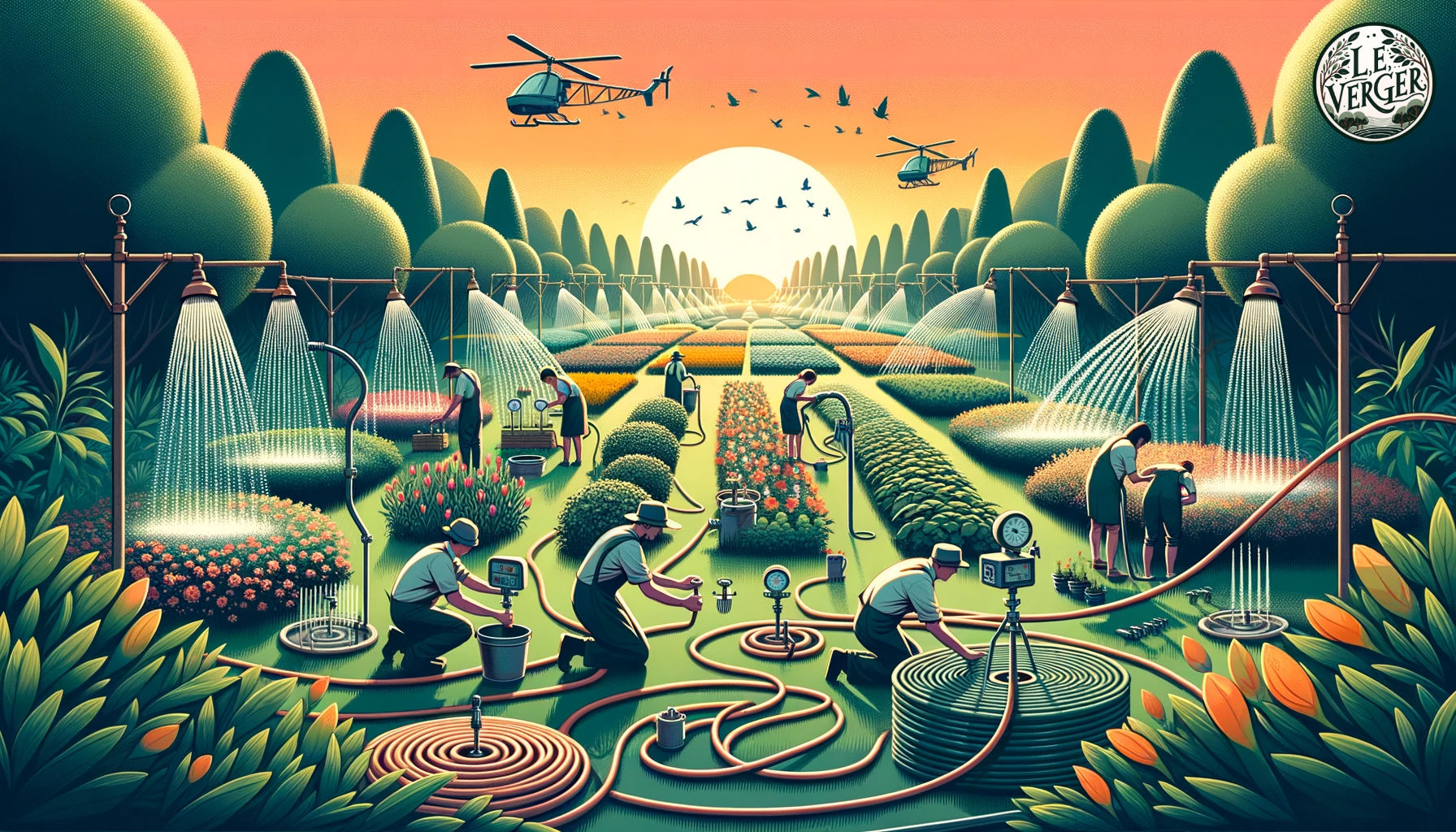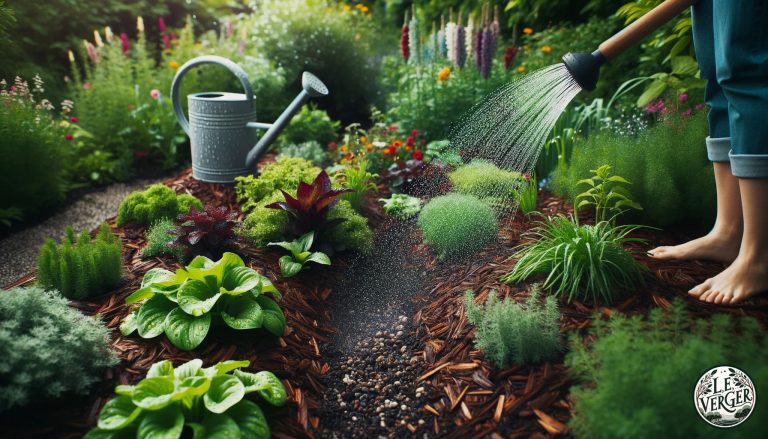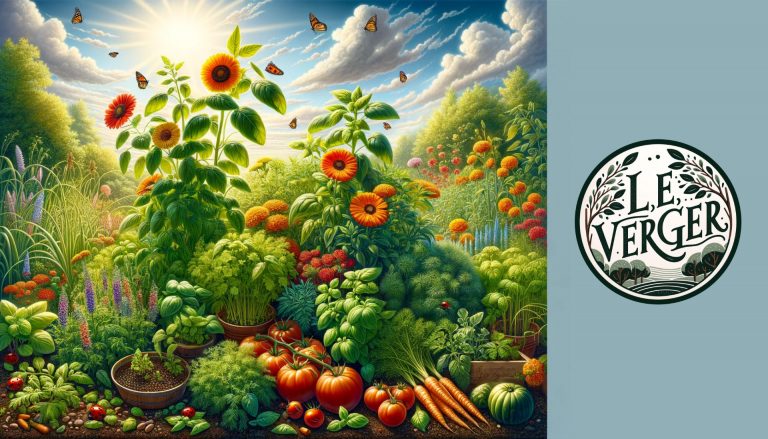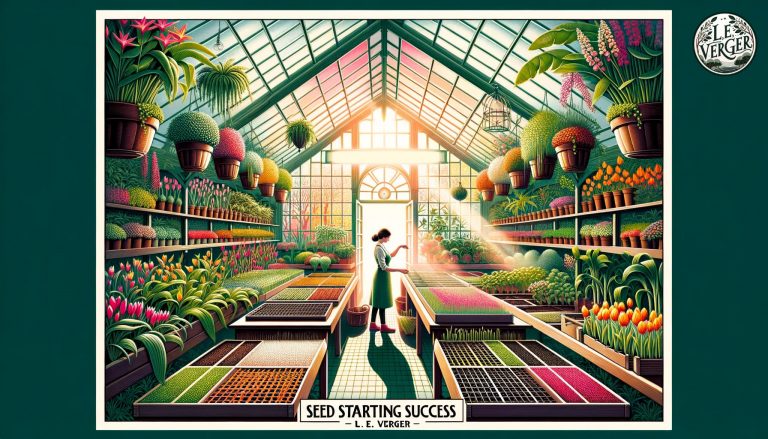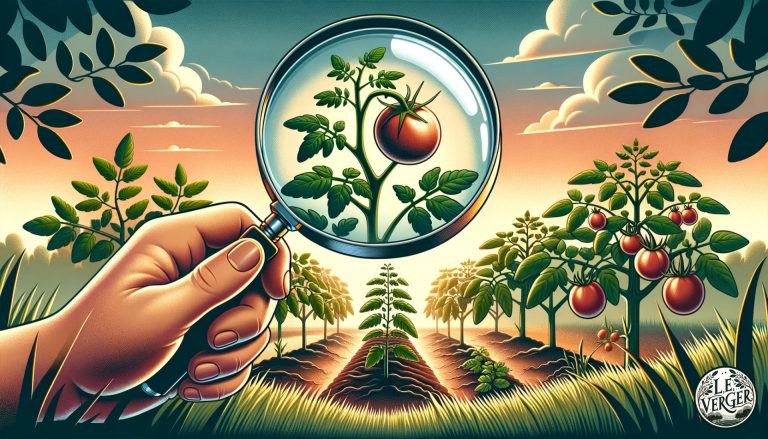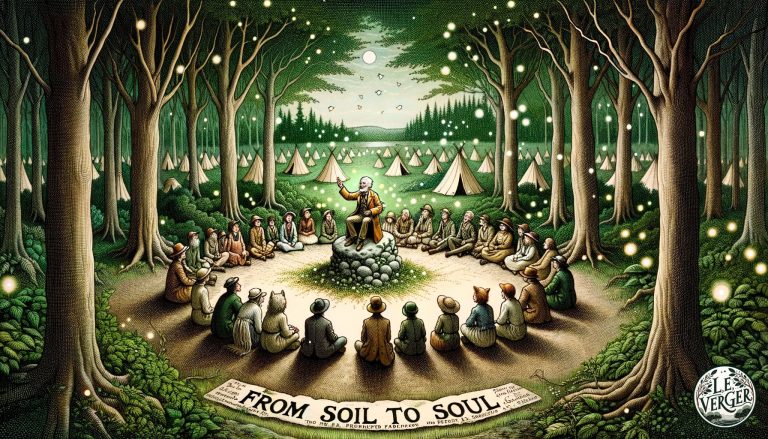Water Wisdom: Efficient Irrigation Strategies for Your Garden
Discover how to transform your garden into a lush oasis without wasting water or money. Our guide on efficient irrigation strategies offers actionable tips on water management, system types, and sustainable practices. Dive in to cultivate a garden that’s both beautiful and eco-friendly.
Water is a precious resource that is essential for the growth and survival of all plants. As a gardener, it is important to understand the importance of water and how to use it efficiently. By implementing smart irrigation strategies, you can not only conserve water but also promote healthy plant growth and reduce your water bills.
About This Garden Irrigation Guide
In this article, we will explore various efficient irrigation strategies that you can use to water your garden. We will cover the basics of irrigation, different types of irrigation systems, installation and setting up, watering techniques for different plant types, timed watering and scheduling, rainwater harvesting and use, maintenance and troubleshooting, and improving soil and water retention. By the end of this article, you will have a comprehensive understanding of how to water your garden efficiently and sustainably.
Key Takeaways
- Understanding the importance of water and efficient irrigation strategies can promote healthy plant growth and reduce water bills.
- There are various types of irrigation systems and watering techniques that you can use to water different plant types and garden types.
- By monitoring water usage and quality, harvesting rainwater, improving soil and water retention, and troubleshooting irrigation systems, you can maintain a sustainable watering solution for your garden.
Understanding the Importance of Water
Water is a precious resource that is essential for the growth and survival of plants. With the effects of climate change, population increase and the need to protect the environment, such as river levels for wildlife, it is important to use water wisely.
When it comes to gardening, it is important to understand the role that water plays in the growth and development of your plants. Water helps to transport nutrients and minerals from the soil to the roots of your plants. Without water, your plants will not be able to grow and thrive.
It is important to note that not all water is created equal. The quality of the water you use can have an impact on the health of your plants. Water with debris or excessive mineral deposits can lead to clogs in irrigation systems and damage to your plants.
In addition to the quality of the water, it is important to consider the amount of water you use. Overwatering can lead to root rot and other issues, while underwatering can cause your plants to wilt and die.
By understanding the importance of water and using it wisely, you can promote healthy plant growth while conserving this precious resource.
Basics of Efficient Irrigation
Efficient irrigation is essential for maintaining a healthy garden while conserving water and reducing water waste. Here are some basic strategies for efficient irrigation:
Water Management
Water management is the key to efficient irrigation. Before you start watering your garden, it is important to understand the water needs of your plants and the soil conditions. You can use a soil moisture meter to determine the moisture level of your soil. This will help you to avoid overwatering or underwatering your plants.
Water Efficiency
Water efficiency is all about using the right amount of water at the right time. You can use drip irrigation systems, which deliver water directly to the roots of your plants, to reduce water waste. Drip irrigation systems also help to prevent water evaporation and runoff.
Conserve Water
Conserving water is an important part of efficient irrigation. You can use a rain barrel to collect rainwater, which can be used to water your garden. You can also mulch your garden with organic materials, such as leaves, grass clippings, or wood chips, to help retain moisture in the soil.
Water Waste
Water waste is a major problem in many gardens. You can reduce water waste by fixing leaky hoses and sprinklers, and by avoiding watering your garden during the hottest part of the day when water evaporation is at its highest.
By following these basic strategies for efficient irrigation, you can maintain a healthy garden while conserving water and reducing water waste.
Types of Irrigation Systems
When it comes to watering your garden, there are several types of irrigation systems to choose from. Each type has its own advantages and disadvantages, so it’s important to choose the one that best fits your needs.
Drip Irrigation System
Drip irrigation is a popular choice for gardeners who want to conserve water while keeping their plants healthy. This type of system uses a network of tubes and emitters to deliver water directly to the base of each plant. Because the water is delivered slowly and directly to the roots, there is less waste and evaporation than with other types of irrigation systems. Drip irrigation is also easy to install and maintain, making it a great choice for beginners.
Sprinkler System
Sprinkler systems are another popular choice for gardeners. They use a network of pipes and sprinkler heads to deliver water to your plants. Sprinkler systems are great for covering large areas quickly and evenly, but they can be less efficient than drip irrigation systems. They can also be more expensive to install and maintain.
Soaker Hoses
Soaker hoses are a type of drip irrigation system that uses a porous hose to deliver water directly to the base of your plants. They are easy to install and can be used in a variety of garden settings. Soaker hoses are also a great choice for gardeners who want to conserve water.
Drip Tape
Drip tape is similar to soaker hoses, but it uses a flat, flexible tape instead of a hose. Drip tape is easy to install and can be used in a variety of garden settings. It is also a great choice for gardeners who want to conserve water.
Choosing the right irrigation system for your garden depends on your specific needs and preferences. Drip irrigation is a great choice for conserving water and delivering water directly to the roots of your plants. Sprinkler systems are great for covering large areas quickly and evenly. Soaker hoses and drip tape are both easy to install and can be used in a variety of garden settings. Consider your garden’s size, layout, and watering needs when choosing an irrigation system.
Installation and Setting Up
Setting up an efficient irrigation system for your garden can be a game-changer in terms of saving time, water, and money. Here are some tips for installing and setting up your irrigation system:
1. Choose the right kit
First, choose the right irrigation kit for your garden. Consider the size of your garden, the type of plants you have, and your water source. There are various types of kits available, including drip irrigation, micro-sprinklers, and soaker hoses. Drip irrigation is a popular choice as it delivers water directly to the roots of the plant, minimizing water wastage.
2. Install the tubing
Once you have your kit, it’s time to install the tubing. Lay out the tubing along the plants’ rows, making sure to keep the tubing straight and taut. Use stakes to hold the tubing in place. Be careful not to kink the tubing, as this can reduce water flow.
3. Connect the pump
If you have a large garden, you may need a pump to boost water pressure. Connect the pump to your water source and the irrigation system. Make sure to follow the manufacturer’s instructions carefully.
4. Set up the pressure regulator
To ensure that your irrigation system works efficiently, you need to set up a pressure regulator. The regulator will control the water pressure and prevent damage to the tubing and emitters. Install the regulator between the pump and the irrigation system.
5. Test the water pressure
Before you start watering your plants, test the water pressure to make sure it’s at the right level. Use a pressure gauge to measure the water pressure at the beginning and end of the tubing. Adjust the pressure regulator as needed to ensure that the pressure is consistent throughout the system.
By following these tips, you can install and set up an efficient irrigation system for your garden. This will not only save water and money but also ensure that your plants get the water they need to thrive.
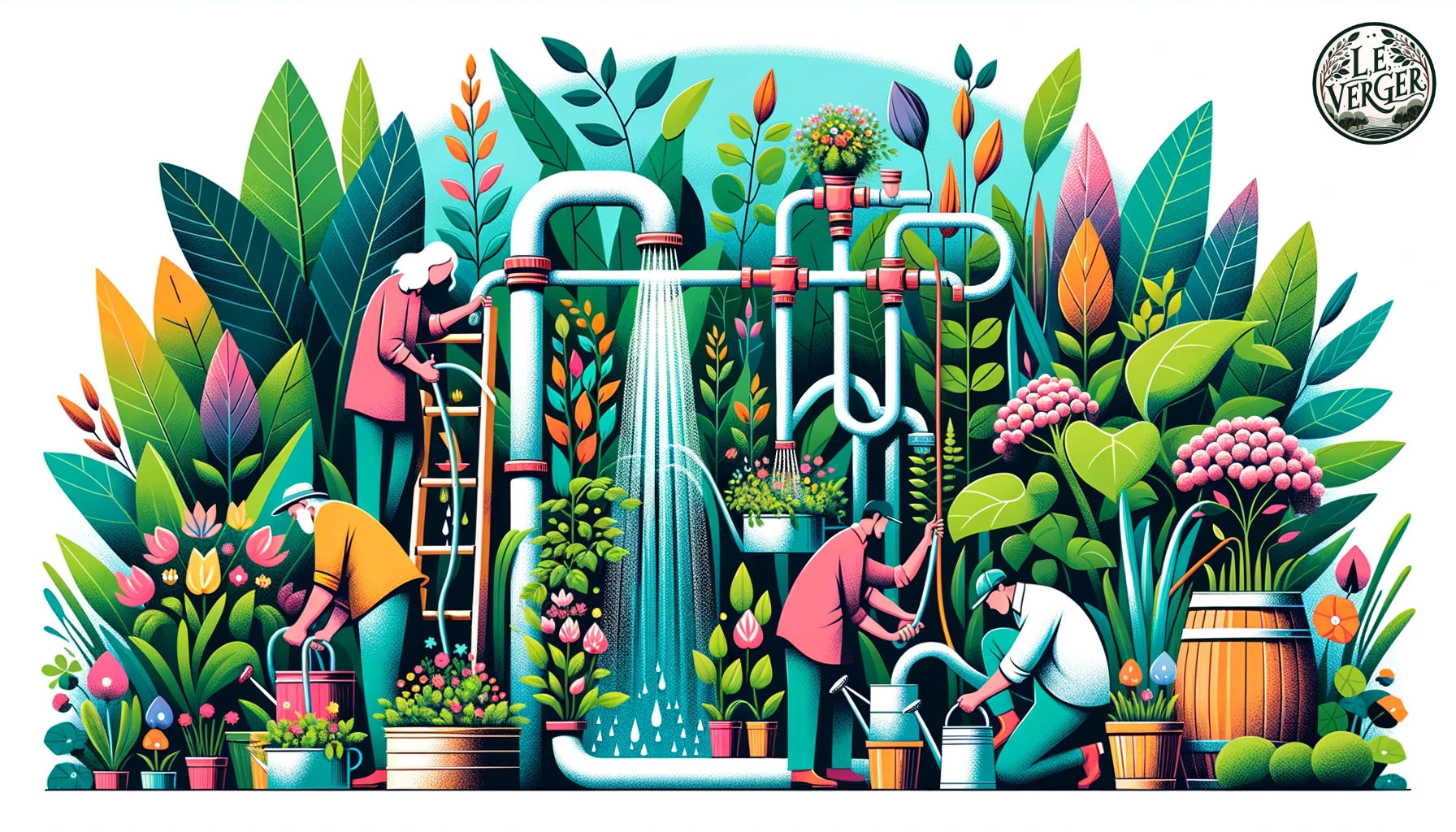
Irrigation Practices for Different Plants
Efficient irrigation practices are crucial for the health and growth of your garden plants, crops, trees, seedlings, and tomatoes. Different types of plants have different water requirements, and it is essential to understand these requirements to avoid over or under-watering.
Watering Frequency
The frequency of watering depends on the type of plant and the weather conditions. For instance, young seedlings require frequent watering, whereas mature trees need less frequent watering. Tomatoes require regular and consistent watering to prevent blossom end rot.
Watering Depth
The depth of watering is also important. Shallow watering can lead to poor root development, while deep watering encourages deep root growth. Generally, most plants require watering to a depth of 6-8 inches.
Watering Methods
There are different methods of watering, including drip irrigation, sprinklers, and hand watering. Drip irrigation is a highly efficient method that delivers water directly to the roots of the plants, reducing water wastage. Sprinklers are suitable for large areas, while hand watering allows you to control the amount of water delivered to each plant.
Soil Type
Soil type also plays a significant role in irrigation. Sandy soils drain water quickly, while clay soils retain water for longer periods. Understanding your soil type can help you determine the appropriate frequency and amount of watering required.
Water Conservation
Water conservation is essential, especially in areas prone to drought. You can conserve water by mulching around plants, using rainwater harvesting systems, and avoiding watering during the hottest part of the day.
Efficient irrigation practices are critical for the health and growth of your garden plants. Understanding the watering requirements of your plants, the frequency and depth of watering, the appropriate watering methods, and the soil type can help you achieve optimal results. Water conservation practices can also help you save water and reduce your water bill.
Watering Techniques for Various Garden Types
Different types of gardens require different watering techniques to ensure efficient irrigation. Here are some tips for watering different garden types:
Home Gardens
For home gardens, it’s best to use a drip irrigation system or a soaker hose. These systems allow water to slowly seep into the soil, reaching the roots of your plants without wasting water. Alternatively, you can water your garden by hand using a watering can or a hose with a watering wand attachment. Be sure to water deeply and thoroughly, so the water reaches the roots of your plants.
Container Gardens
Container gardens require more frequent watering than in-ground gardens because the soil in containers dries out faster. Check your containers daily and water them when the soil feels dry to the touch. Be sure to water until the excess water drains out the bottom of the container. Consider using a self-watering container or a watering spike to help maintain consistent moisture levels.
Patio Gardens
Patio gardens can be challenging to water because they are often in direct sunlight and can dry out quickly. Consider using a drip irrigation system or a soaker hose to water your patio garden. Alternatively, you can water your plants by hand using a watering can or a hose with a watering wand attachment. Be sure to water deeply and thoroughly, so the water reaches the roots of your plants.
Raised Bed Gardens
Raised bed gardens require less water than in-ground gardens because the soil in raised beds retains moisture better. Water your raised bed garden deeply and thoroughly once or twice a week, depending on weather conditions. Consider using a drip irrigation system or a soaker hose to water your raised bed garden.
Sloped Gardens
Sloped gardens can be challenging to water because water tends to run off the soil quickly. Consider using a drip irrigation system or a soaker hose to water your sloped garden. Alternatively, you can water your plants by hand using a watering can or a hose with a watering wand attachment. Be sure to water deeply and thoroughly, so the water reaches the roots of your plants. Consider using mulch to help retain moisture in the soil.
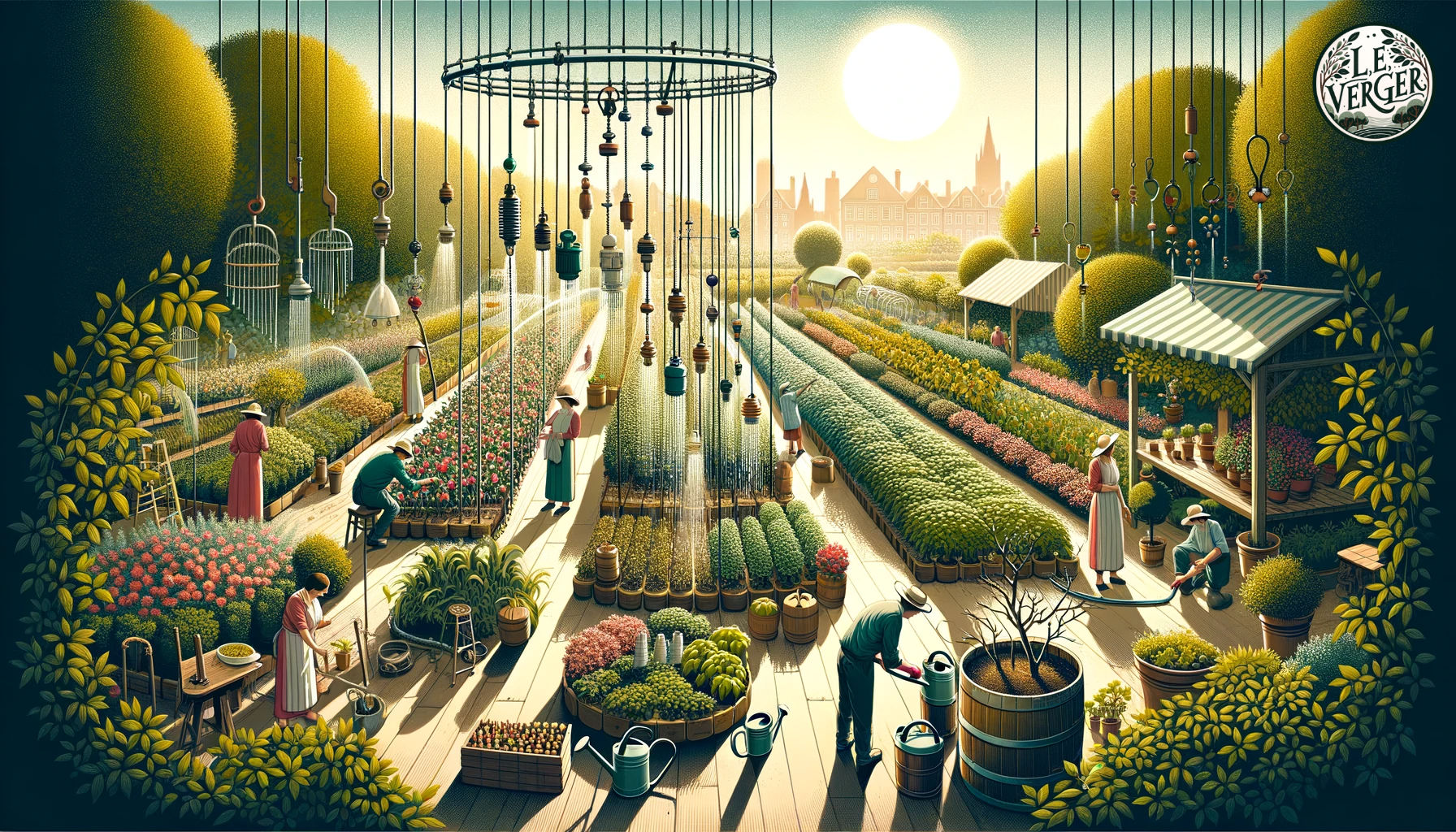
Timed Watering and Scheduling
One of the most efficient irrigation strategies for your garden is timed watering and scheduling. This involves setting up a timer to automatically water your plants at specific times throughout the day or week.
Using a timer ensures that your plants receive a consistent and appropriate amount of water, which is essential for healthy growth. It also helps you save time and water by avoiding overwatering or underwatering your plants.
To set up a timed watering system, you will need a timer that can be attached to your outdoor tap. There are many different types of timers available, ranging from basic models to more advanced smart timers that can be controlled using your smartphone.
Once you have your timer, you will need to set up a watering schedule based on the needs of your plants. This will depend on a variety of factors, including the type of plants you have, the soil type, and the climate in your area.
To determine the best watering schedule for your garden, you can use a soil moisture meter or consult with a gardening expert. Generally, most plants need to be watered once or twice a week, but this can vary depending on the weather and other factors.
When setting up your watering schedule, it is important to consider the time of day when you will be watering your plants. Watering early in the morning or late in the evening is best, as it allows the water to soak into the soil before the heat of the day evaporates it.
Overall, timed watering and scheduling is an effective way to ensure that your plants receive the right amount of water at the right time. By using a timer and setting up a watering schedule, you can save time, water, and ensure that your garden thrives.
Rainwater Harvesting and Use
If you want to be more eco-friendly and save money on your water bill, consider harvesting rainwater for your garden. Rainwater harvesting is the process of collecting and storing rainwater that falls on your roof or other surfaces for later use. This water can be used for irrigation, washing cars, or even flushing toilets.
To get started, you’ll need a rain barrel or water butt. These containers are placed under a downspout to collect rainwater from your rooftop. You can buy them at most garden centres or online. They come in various sizes, so choose one that fits your needs and available space.
Once you have your rain barrel, attach a hose or spigot to the barrel so you can easily access the collected rainwater. If you have a larger garden, you may want to consider connecting the rain barrel to an irrigation system. This will allow you to water your plants more efficiently and effectively.
Using rainwater for irrigation has several benefits. First, it’s free and abundant. Second, it’s better for your plants than tap water because it doesn’t contain chlorine or other chemicals. Third, it reduces stormwater runoff, which can help prevent flooding and erosion.
However, there are some things to keep in mind when using rainwater for irrigation. First, make sure to use it within a few days of collection to prevent the growth of bacteria and algae. Second, don’t use rainwater for edible crops if your roof is made of materials that could contaminate the water, such as asbestos or lead. Third, be mindful of potential mosquito breeding sites, and use mosquito dunks or screens to prevent them from laying eggs in the water.
Overall, rainwater harvesting is a simple and effective way to save water and money while keeping your garden healthy and beautiful.
Maintenance and Troubleshooting
Keeping your irrigation system in good working order is crucial to ensure that your garden stays healthy and well-watered. Here are some tips for maintaining and troubleshooting your irrigation system:
Regular Maintenance
Regular maintenance is essential to keep your irrigation system running smoothly. Here are some things you can do to keep your system in good condition:
- Check your system for leaks regularly. Leaks can cause your system to lose pressure and reduce the efficiency of your irrigation. Fix any leaks you find as soon as possible.
- Clean your filters and screens regularly. Dirt and debris can clog your filters and screens, reducing the flow rate of your irrigation system. Cleaning them regularly will help to maintain your system’s efficiency.
- Inspect your system for damage. Look for any signs of wear and tear, such as cracks or breaks in your pipes or fittings. Replace any damaged parts as soon as possible to prevent further damage to your system.
Winter Maintenance
Winter can be tough on your irrigation system, so it’s important to take steps to protect it during the colder months. Here are some things you can do to prepare your system for winter:
- Drain your system. Before the first frost, drain your irrigation system to prevent any water from freezing and damaging your pipes.
- Insulate your system. If you live in an area with particularly cold winters, consider insulating your pipes to protect them from freezing temperatures.
- Shut off your system. Turn off your irrigation system’s water supply and shut down your controller for the winter.
Troubleshooting
Sometimes, even with regular maintenance, problems can arise with your irrigation system. Here are some common issues and how to troubleshoot them:
- Low flow rate: If your irrigation system is not delivering enough water, check your filters and screens for clogs. You may also need to adjust your water pressure or the size of your pipes to improve your flow rate.
- Leaks: If you notice water pooling around your irrigation system, you may have a leak. Check your system for damaged pipes or fittings, and repair any leaks you find as soon as possible.
- Controller issues: If your irrigation system is not turning on or off when it should, check your controller’s settings and programming. You may need to reset your controller or reprogram it to fix the issue.
By following these maintenance and troubleshooting tips, you can keep your irrigation system running smoothly and your garden healthy and well-watered.
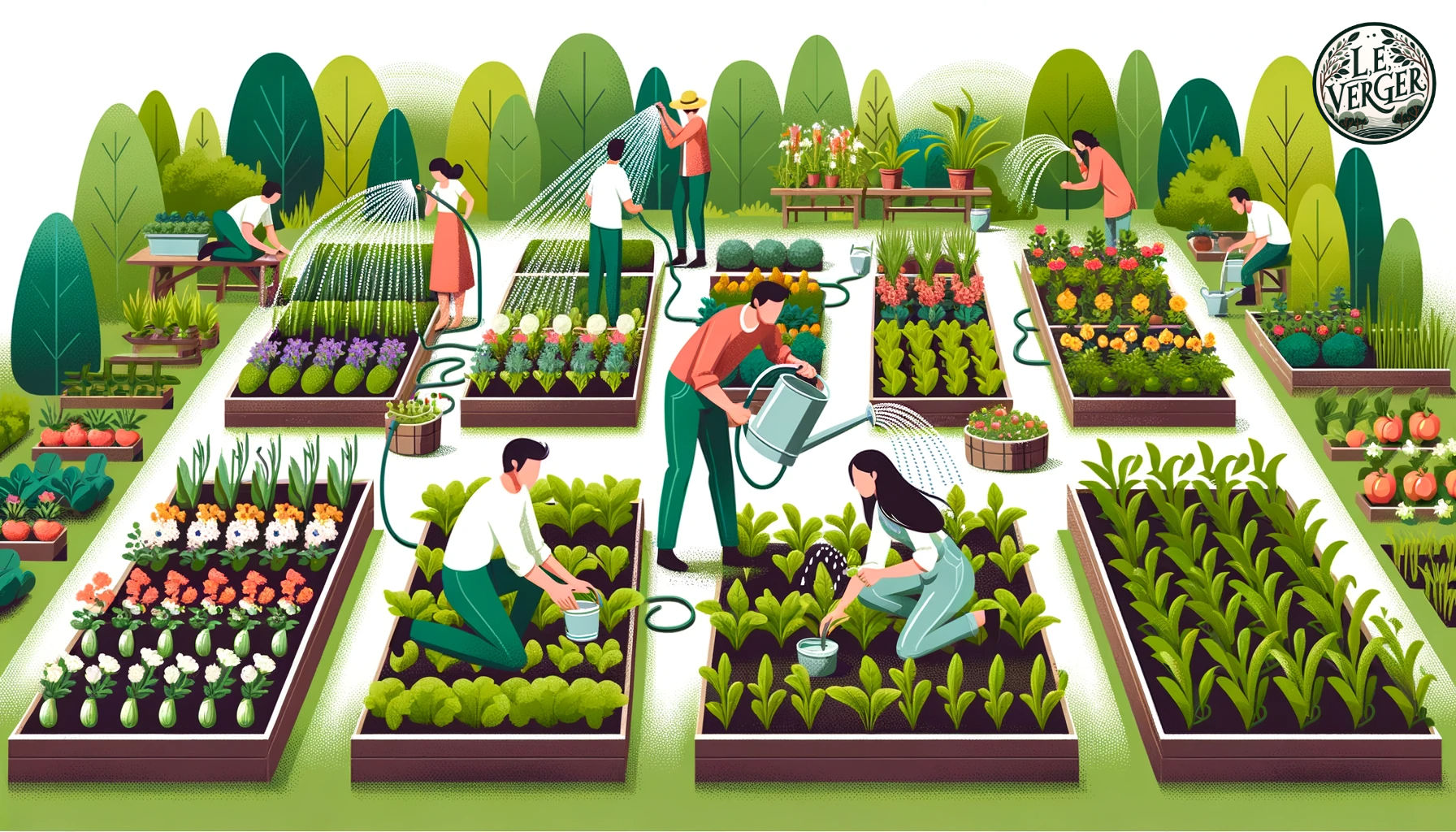
Improving Soil and Water Retention
One of the most important aspects of efficient irrigation is improving soil and water retention. By doing so, you can reduce the amount of water you need to use, save money, and promote healthy plant growth. Here are some tips to help you improve soil and water retention in your garden:
Add Organic Matter
Adding organic matter to your soil can help improve its ability to retain moisture. Organic matter, such as compost, manure, or leaf mould, can increase the soil’s water-holding capacity and reduce the amount of water lost to evaporation. It can also help to improve soil structure, which can reduce the risk of runoff.
Use Mulch
Mulch is a layer of material, such as straw, leaves, or wood chips, that is placed on top of the soil. It can help to reduce evaporation, keep the soil cool, and prevent weed growth. Additionally, mulch can help to improve soil structure and water-holding capacity.
Water Efficiently
Watering your garden efficiently can also help to improve soil and water retention. One way to do this is to water deeply and infrequently, rather than shallowly and frequently. This encourages the plant roots to grow deeper into the soil, where they can access water more easily. Additionally, watering during the early morning or late evening can help to reduce evaporation.
Prevent Runoff
Runoff occurs when water flows over the surface of the soil, rather than soaking into it. This can result in water wastage and soil erosion. To prevent runoff, try to water your garden slowly and evenly, rather than in a single heavy burst. You can also use contouring or terracing to help slow down the flow of water and encourage it to soak into the soil.
By following these tips, you can improve soil and water retention in your garden, reduce water wastage, and promote healthy plant growth.
Monitoring Water Usage and Quality
Efficient irrigation strategies require monitoring water usage and quality. By doing so, you can ensure that your garden is getting just the right amount of water it needs without wasting any. Here are some tips for monitoring water usage and quality in your garden:
Moisture Sensors
A moisture sensor is a handy tool that measures the moisture level in your soil. It can help you determine when your plants need water, so you don’t overwater or underwater them. You can purchase a moisture sensor from your local garden centre or online. Some moisture sensors are wireless and can be connected to your smartphone, making it easy to monitor your garden’s moisture levels.
Water Quality
Water quality is an important factor to consider when watering your garden. If your water contains high levels of minerals or other contaminants, it can affect the health of your plants. You can have your water tested by a professional or purchase a water testing kit to test it yourself. If your water quality is poor, you may need to install a filtration system or use a different water source for your garden.
Filtration
If you have poor water quality, installing a filtration system can help remove contaminants and improve the health of your plants. There are different types of filters available, including sediment filters, carbon filters, and reverse osmosis filters. You can consult with a professional to determine which type of filter is best for your garden.
Filters
Filters can help prevent clogs in your irrigation system and ensure that water is distributed evenly throughout your garden. There are different types of filters available, including screen filters, disc filters, and sand filters. You can consult with a professional to determine which type of filter is best for your irrigation system.
By monitoring water usage and quality in your garden, you can ensure that your plants are getting the right amount of water they need to thrive. Consider using moisture sensors, testing your water quality, installing a filtration system, and using filters to improve the efficiency of your irrigation system.
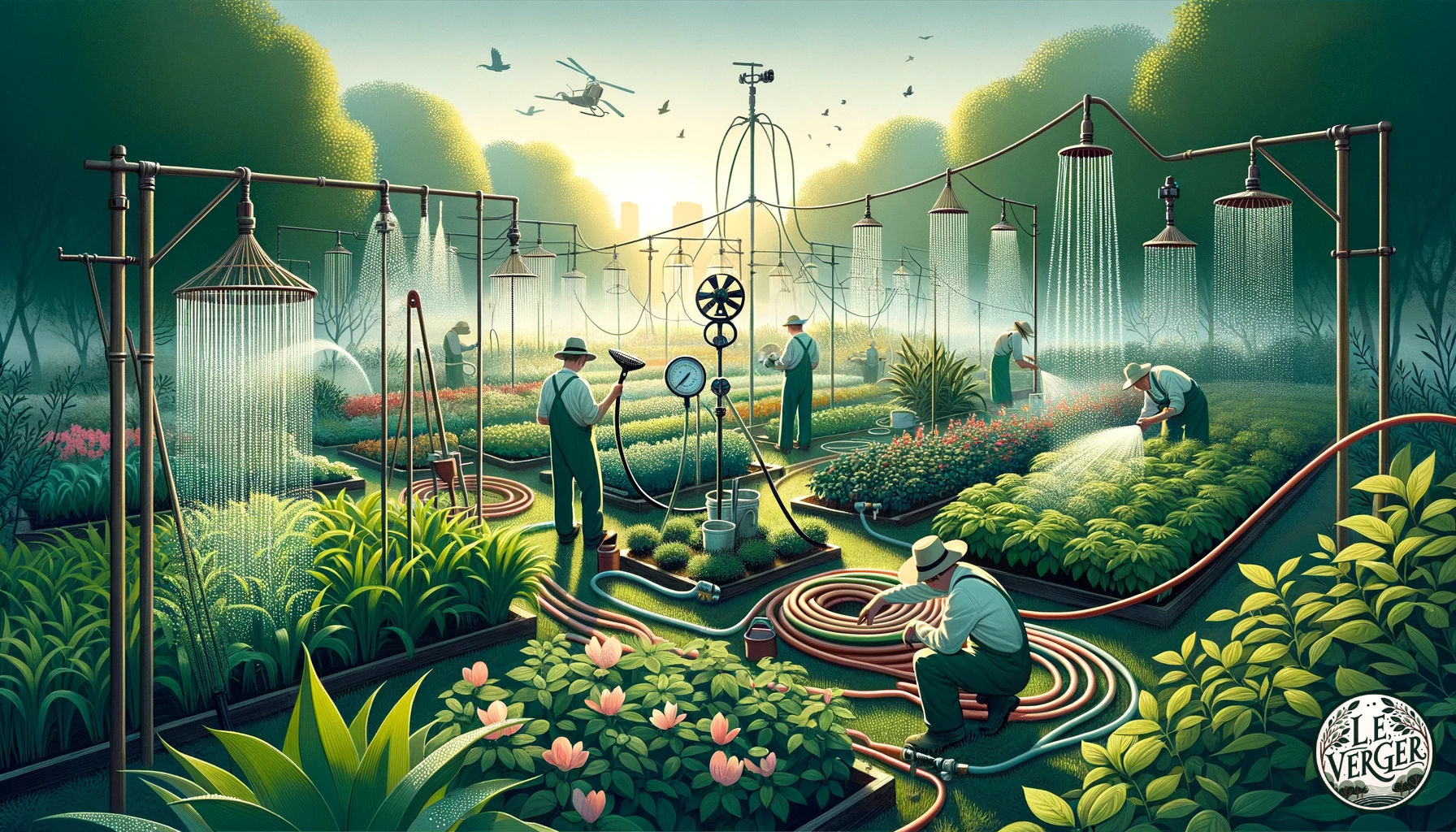
Conclusion: Sustainable Watering Solutions
Congratulations! You are now equipped with the knowledge and tools to implement sustainable watering solutions in your garden. By choosing the right watering solution and watering methods, you can save water, reduce your water bill, and help the environment.
Using a watering can is a great way to save water and ensure that your plants get the right amount of water. It allows you to water your plants directly at the root, avoiding water waste and runoff. Plus, it’s a great arm workout!
Remember to water your plants in the morning or evening when the sun is not as strong to reduce water evaporation. This will help your plants absorb more water and reduce the need for frequent watering.
In this article, we have covered a range of sustainable watering solutions, including drip irrigation, soaker hoses, and rainwater harvesting. Each of these methods has its advantages and disadvantages, so choose the one that best suits your garden’s needs.
In the end, it’s all about finding the right balance between water conservation and plant health. By implementing the tips and techniques outlined in this article, you can ensure that your garden thrives while reducing your water usage.
Thank you for reading this article on efficient irrigation strategies for your garden. We hope you found it informative and helpful. Happy gardening!

